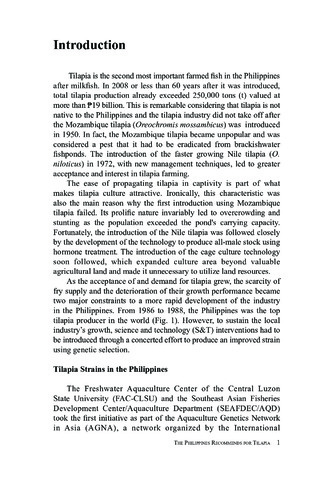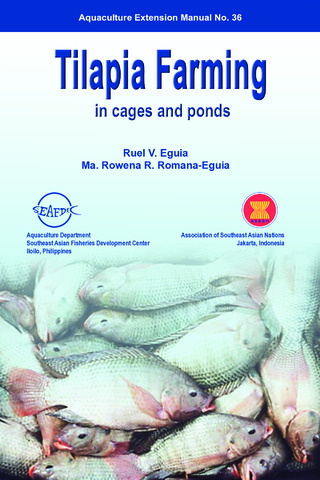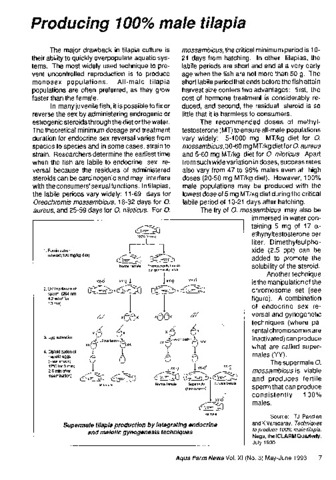| dc.contributor.author | Romana, Maria Rowena R. | |
| dc.contributor.editor | Pullin, R. S. V. | |
| dc.contributor.editor | Bhukaswan, T. | |
| dc.contributor.editor | Tonguthai, K. | |
| dc.contributor.editor | Maclean, J. L. | |
| dc.date.accessioned | 2011-06-22T09:35:13Z | |
| dc.date.available | 2011-06-22T09:35:13Z | |
| dc.date.issued | 1988 | |
| dc.identifier.uri | http://hdl.handle.net/10862/308 | |
| dc.description.abstract | Preliminary electrophoretic screening of laboratory maintained tilapia stocks revealed enzyme polymorphism at 3 co-dominantly inherited loci--adenosine deaminase (Ada), aminopeptidase (Ap) and malic enzyme (Me-2). Oreochromis niloticus and O. aureus broodstock used in artificial gynogenesis and polyploidy experiments were genetically tagged with these biochemical markers. Results of manipulations to induce diploid gynogenetic and triploid broods from heterozygous females were determined by genetic analysis.
Segregation ratios in the control broods confirmed Mendelian inheritance at the Me-2 and Ada loci. Genetic analysis of enzyme polymorphism in gynogenetic broods, produced from ova fertilized with genetically inert sperm and heat-shocked 5 minutes after fertilization indicated diploidy restoration by second polar body retention. Diploidisation of gynogenomes by suppression of first cleavage of mitosis in the zygote, attempted by heat shocking eggs 20-45 minutes after fertilization with UV-treated sperm, proved effective in one brood (heat shock at 45 min. after fertilization) in which a high incidence (~100% ) of individuals homozygous for Me-2, was observed. Finally, electrophoretic analysis of triploids revealed banding patterns different from those observed in normal and gynogenetic diploids. Such as banding phenotypes, peculiar only to triploids, denoted success in triploidy induction which was achived here with the fusion of the pronucleus and the maternal genome made double by suppresion of meiosis II. | en |
| dc.language.iso | en | en |
| dc.publisher | Department of Fisheries | en |
| dc.publisher | International Center for Living Aquatic Resources Management. ICLARM Conference Proceedings 15 | en |
| dc.relation.ispartof | In: Pullin, R.S.V., Bhukaswan, T., Tonguthai, K., Maclean, J.L., (eds.). The Second International Symposium on Tilapia in Aquaculture, 16-20 March 1987, Bangkok, Thailand. Bangkok, Thailand: Department of Fisheries; Manila, Philippines: International Center for Living Aquatic Resources Management. ICLARM Conference Proceedings 15. pp. 267-274 | en |
| dc.subject | tilapia culture | en |
| dc.subject | genetics | en |
| dc.subject | electrophoresis | en |
| dc.subject | Philippines | en |
| dc.subject | Nile tilapia | en |
| dc.subject | tilapia | en |
| dc.subject | Oreochromis niloticus | en |
| dc.subject | Oreochromis aureus | en |
| dc.subject.lcc | VF SP 098 | |
| dc.title | Electrophoretic studies on induced gynogenetic diploids and triploids in tilapia (Oreochromis niloticus and O. aureus) | en |
| dc.type | Conference paper | en |
| dc.citation.spage | 267 | |
| dc.citation.epage | 274 | |
| dc.subject.asfa | breeding stock | en |
| dc.subject.asfa | electrophoresis | en |
| dc.subject.asfa | enzymes | en |
| dc.subject.asfa | polyploids | en |
| dc.citation.conferenceTitle | The Second International Symposium on Tilapia in Aquaculture, 16-20 March 1987, Bangkok, Thailand | en |
| dc.subject.scientificName | Oreochromis niloticus | en |
| dc.subject.scientificName | Oreochromis aureus | en |



